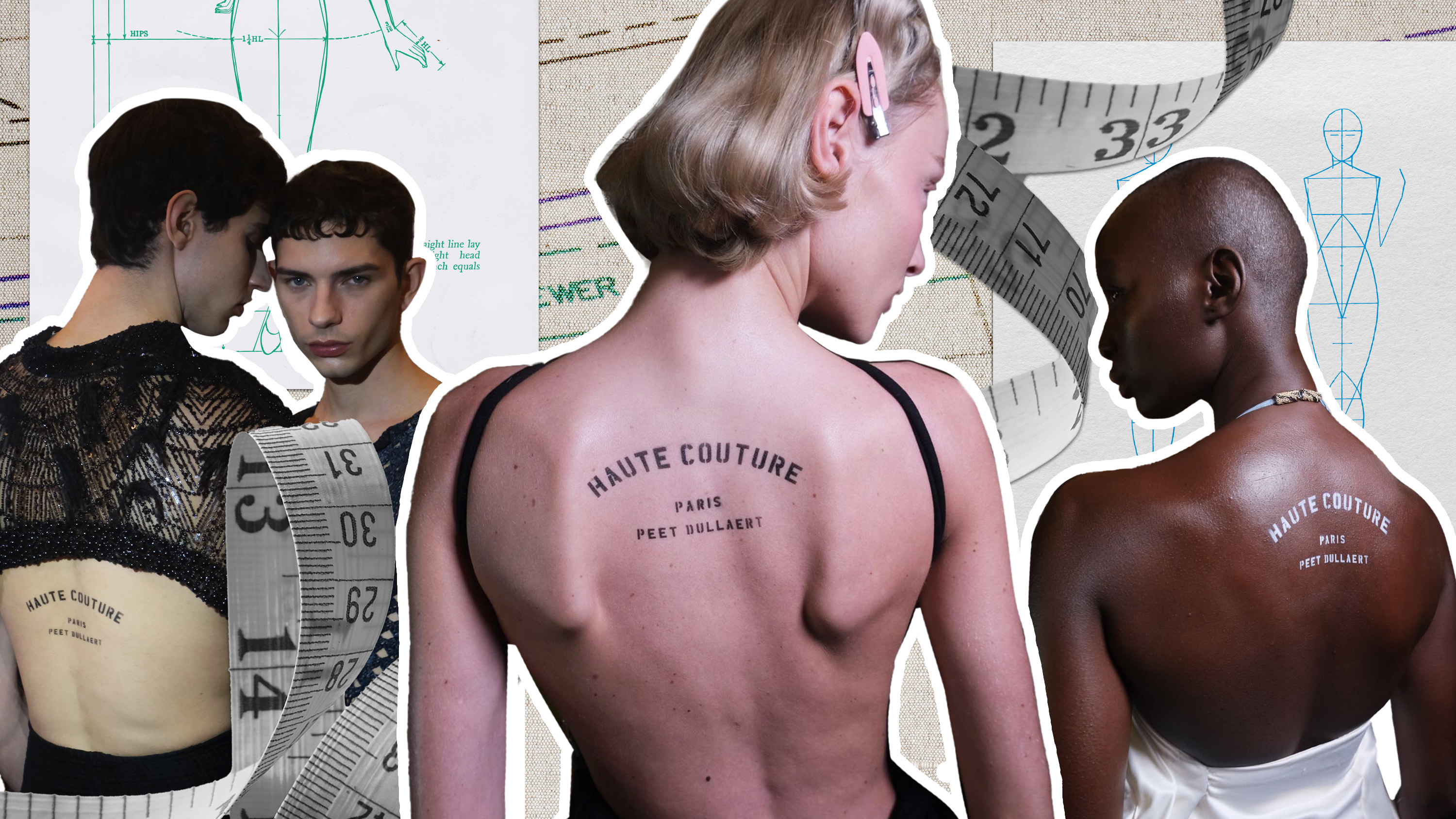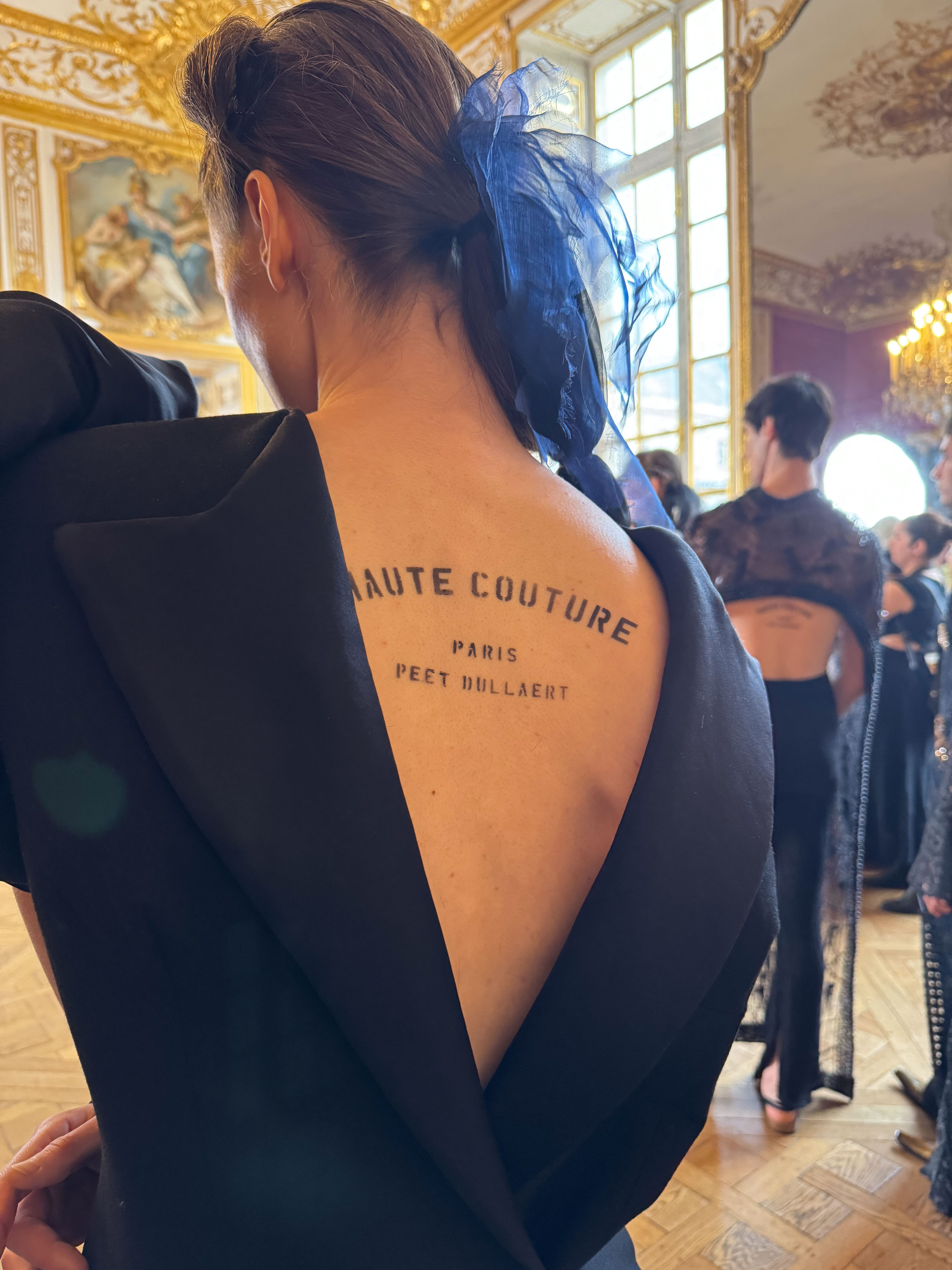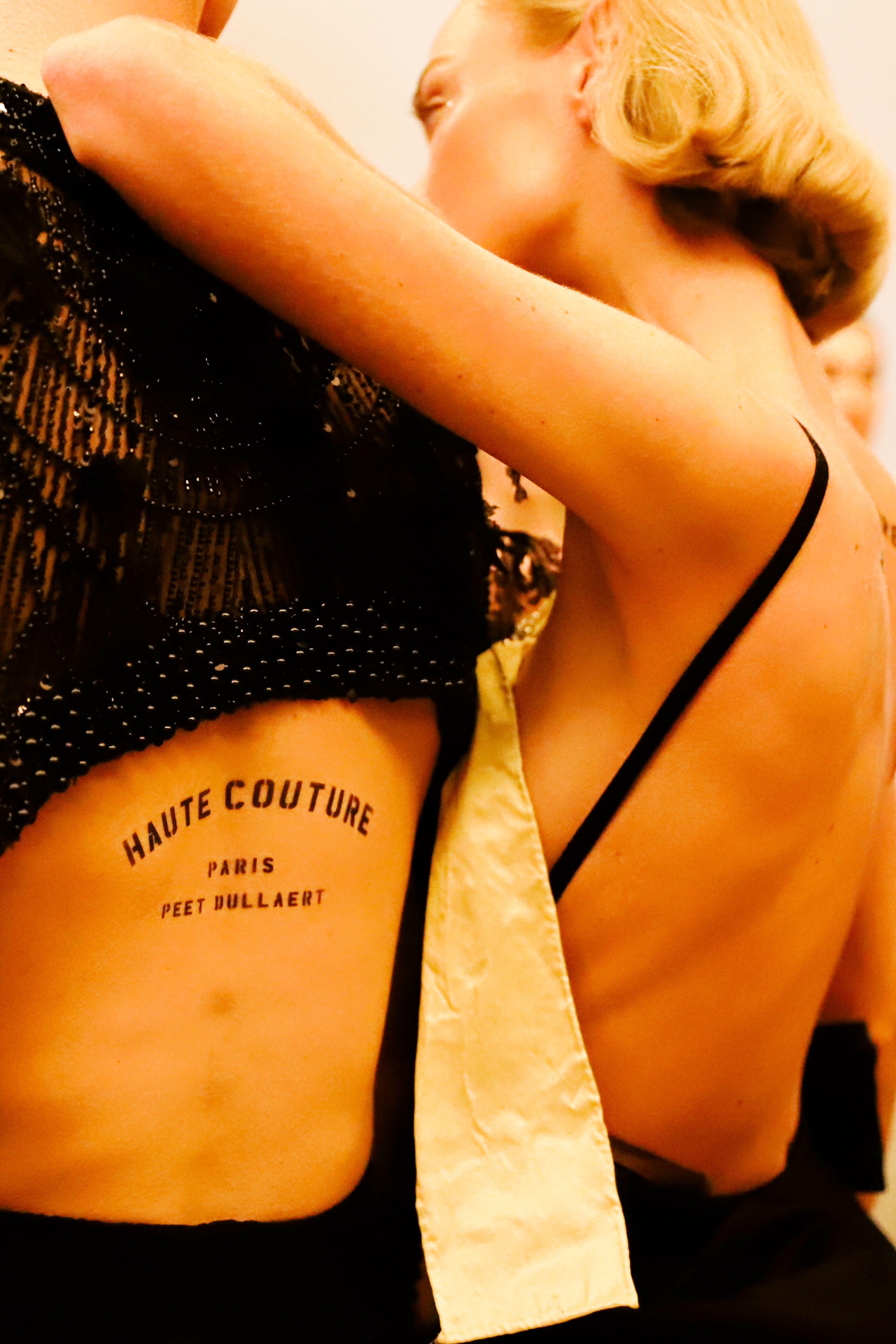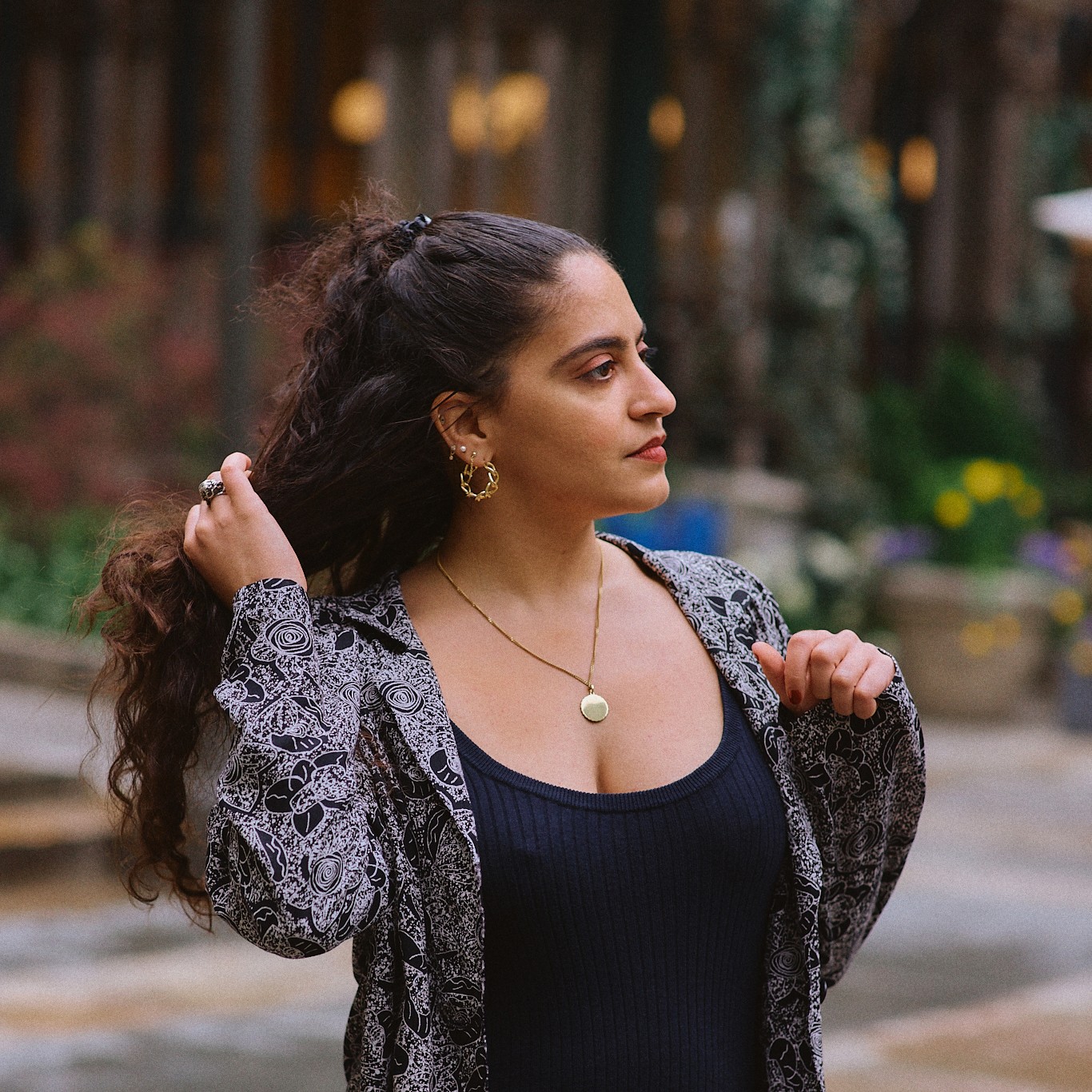Peet Dullaert's Paris Couture Week Beauty Was a Comment on Consumerism
Fashion month has something to learn from Peet Dullaert's striking makeup direction.


Every year at Paris Fashion Week, designers enlist makeup artists' help to enhance their designs. Pat McGrath, for instance, made history this season with her gorgeous, dewy looks at the Maison Margiela Artisanal Spring/Summer 2024 show. That same day, another artist utilized makeup in a fascinating way: Hannah Rosie Bennett, a National Senior Makeup Artist for MAC Cosmetics, sprayed labels onto the skin of the models who walked the Peet Dullaert show. Now, just a few days into the start of the regular season, the painted wording set a memorable example of using beauty to make a bold statement.
This isn't the first time that Dullaert has executed a look like this one, either: Last year, his team sprayed the same label, which says, "Haute Couture, Paris, Peet Dullaert," onto the models' hair.
"I also worked with Peet last season," Bennett tells Marie Claire, explaining that both seasons' makeup looks incorporated vibrant blush that sits high on the models' cheekbones to "lift and sculpt" their faces. She adds, "The same goes with the stamp, only last time it was on the hair and this time it was on the body."

A model walks down the runway at the Peet Dullaert SS24 show at Paris Fashion Week.
Although hair and skin have very different textures, the methodology was surprisingly similar. Last year, hairstylist Alexandry Costa sprayed makeup onto models' hair, and this year, Bennet sprayed MAC Cosmetics' professional-grade airbrush paint onto their backs.
"There's a liquid that goes into a machine, and then we sprayed it onto their backs," she explains. "One design was done with a sponge because we had to do it while the model was wearing clothes, so we did it with a body paint and sponged it on."
The use of the logo, particularly on a human body, raises questions about the makeup's meaning. The fashion industry has a long, often troubled history, particularly when it comes to its relationship with women's bodies. Models have been encouraged to lose weight so that they can fit into impossibly tiny sample sizes; women of color, shorter women, and disabled women don't often have many opportunities within the industry. Furthermore, on runways, models typically wear pared down makeup, slicked back hair, and even bleached eyebrows—simplifying their faces so that all attention will be directed to the clothing.

Models backstage at the Peet Dullaert Paris Fashion Week SS24 show.
The world of modeling for haute couture is, in many ways, a homogenous and even dehumanizing one. Spray painting labels—particularly painting the name of a white man onto the skin of a group of women, including women of color—can be viewed as an extreme expression of this homogeneity. But Bennett counters this idea, explaining that the label is actually meant to highlight a sense of individuality for both the models and the brand.
Get exclusive access to fashion and beauty trends, hot-off-the-press celebrity news, and more.
"The couture stamp, or logo, comes from the fact that couture designs are bespoke, one-off pieces and that the mannequins are made-to-measure for the clients," she says. "So, that stamp is the same one that they have on the mannequins. Of course, we're not saying that the models are mannequins. It's really saying that everything is individually made, the same way that the models are individual people."
In that vein, Dullaert's painted-on labels can also be viewed, at first glance, as performance art that calls attention to hyper-homogeneity. After all, artists like Banksy often call out social issues in their work, utilizing the symbolism of problematic status quos as a tongue-in-cheek way of subverting them. Perhaps, by labelling models in a way that seemingly commodifies them, the labels are meant to call out high fashion's commodification of human beings.

A closer look at one of Peet Dullaert's stamps.
"The labels could have been read both ways, and they get a conversation going about the true meaning behind it," Bennett agrees. "Everything about Peet's designs are complete opposites: the materials, the tailoring, the way he lays the clothing. There's nothing about it that is mass-produced, so if anyone can make that remark, in a way, it's a couture house like Peet Dullaert, because everything is so tailor-made."
Of course, this wasn't the only aspect of Dullaert's looks that Bennett was responsible for. Her team also executed luxe, colorful looks on the faces of the models, inspired by the 18th century locale the show took place in, which was used to film scenes in Sofia Coppola's Marie Antoinette. Bennett says that the makeup she chose echoed the Versailles era, but with a modern twist.
"So the skin was really glowy and pearlescent and decadent," she describes. "We did gemstones instead of beauty marks...Sometimes they were on the dimples or on the cheek or on the inner corner of the eye, but they were very subtle little gemstones."

"The labels could have been read both ways, and they get a conversation going about the true meaning behind it," the show's makeup artist said.
This opulence goes hand in hand with the nebulous symbolism behind Dullaert's spray painted labels: Both represent the dual allures and pitfalls of late capitalism and aggressive consumption. Such deep, conceptual work is, according to Bennett, a hallmark of working with Dullaert.
"Working with Peet is a very emotional process. It's more like we're having conversations about how we're feeling and what we get inspired by," she says. "For him, it's about everything being bespoke rather than following a trend, and it's really about tailoring to the individuality, so I think that's why the stamp is important. It references the couture designs and the couture mannequins, which are made for the client."
Regardless of any one person's interpretation of the labels, they've achieved one goal that all creatives dream of during fashion month: They've ignited conversation.
"Peet has amazing ideas, and working with him and Alexandry Costa for the hair was a really great collaboration," agrees Dullaert. "We were able to create something really beautiful, but also make a statement at the same time."

Gabrielle Ulubay is a Beauty Writer at Marie Claire. She has also written about sexual wellness, politics, culture, and fashion at Marie Claire and at publications including The New York Times, HuffPost Personal, Bustle, Alma, Muskrat Magazine, O'Bheal, and elsewhere. Her personal essay in The New York Times' Modern Love column kickstarted her professional writing career in 2018, and that piece has since been printed in the 2019 revised edition of the Modern Love book. Having studied history, international relations, and film, she has made films on politics and gender equity in addition to writing about cinema for Film Ireland, University College Cork, and on her personal blog, gabrielleulubay.medium.com. Before working with Marie Claire, Gabrielle worked in local government, higher education, and sales, and has resided in four countries and counting. She has worked extensively in the e-commerce and sales spaces since 2020, and spent two years at Drizly, where she developed an expertise in finding the best, highest quality goods and experiences money can buy.
Deeply political, she believes that skincare, haircare, and sexual wellness are central tenets to one's overall health and fights for them to be taken seriously, especially for people of color. She also loves studying makeup as a means of artistic expression, drawing on her experience as an artist in her analysis of beauty trends. She's based in New York City, where she can be found watching movies or running her art business when she isn't writing. Find her on Twitter at @GabrielleUlubay or on Instagram at @gabrielle.ulubay, or follow her art at @suburban.graffiti.art